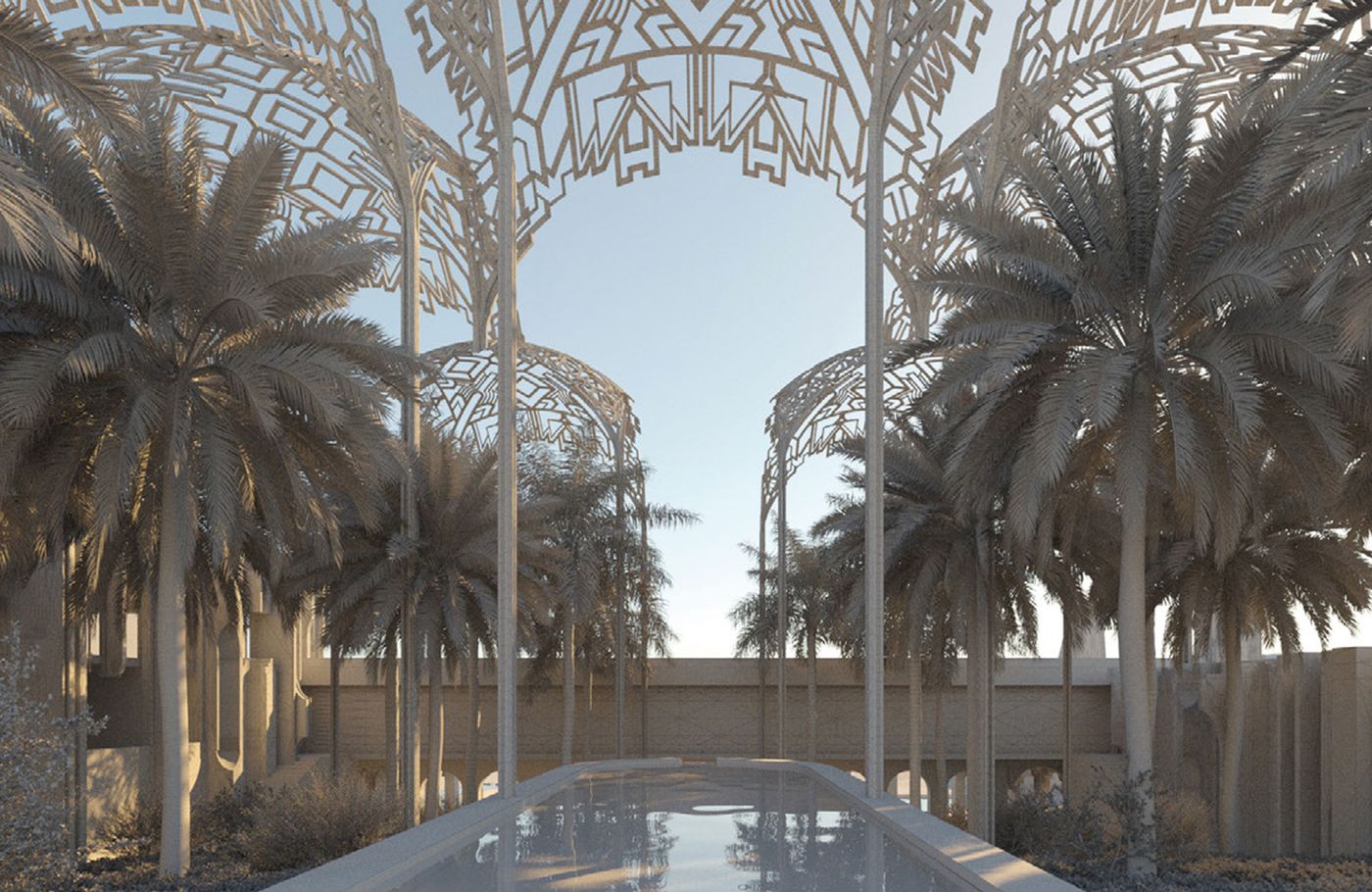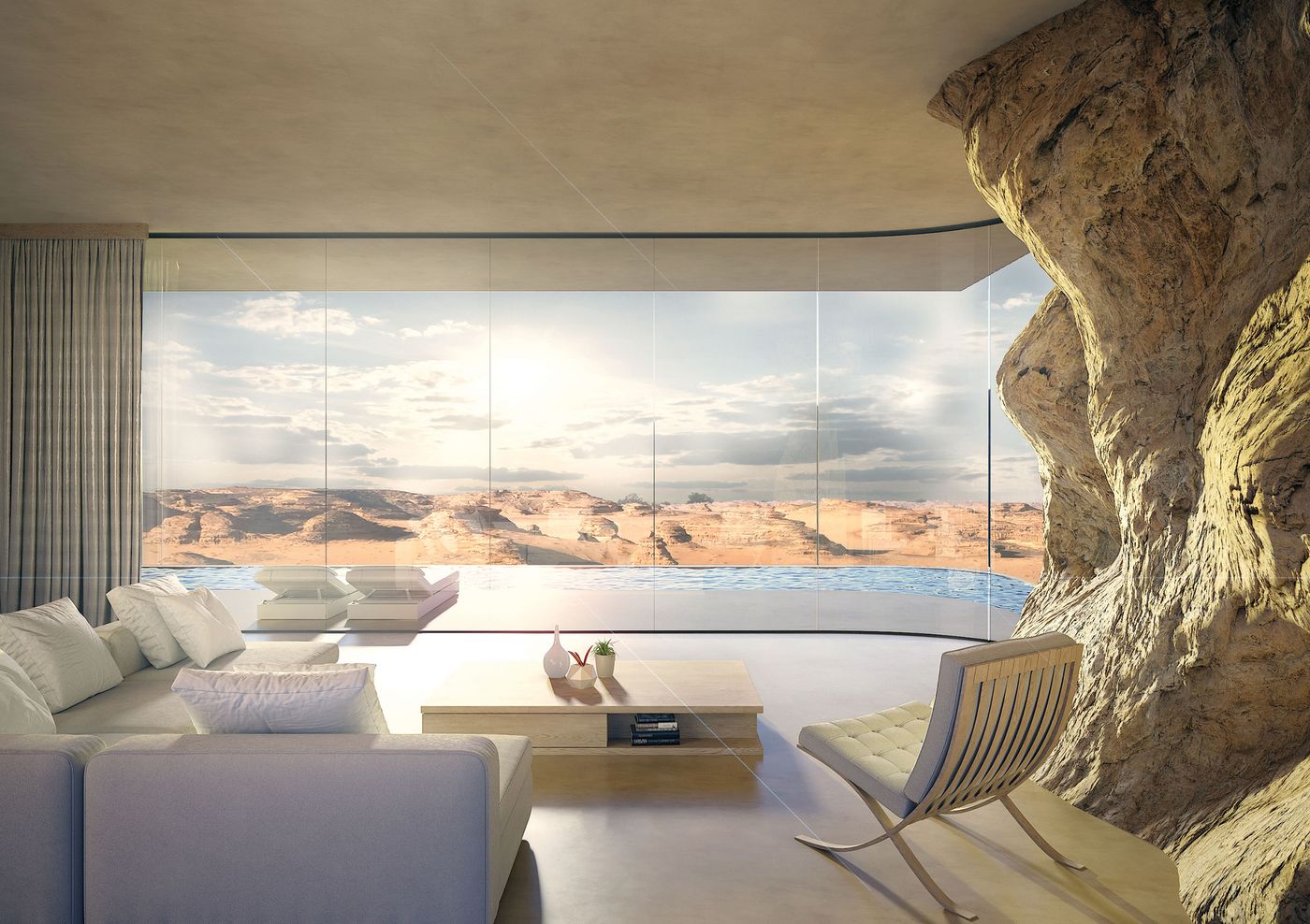
Mark Foster Gage Reinvents the Architectural Monogram with a Fantastical Desert Retreat in Saudi Arabia
Words by Eric David
Location
Mark Foster Gage Reinvents the Architectural Monogram with a Fantastical Desert Retreat in Saudi Arabia
Words by Eric David
From the Renaissance rediscovery of Vitruvius, to Le Corbusier’s encyclopaedic “Oeuvre complete” issued in eight volumes between 1929 and 1970, to Rem Koolhaas’s 1996 blockbuster S,M,L,XL, architectural monograms have been crucial in exploring and disseminating architectural ideas, but they have also been an effective tool to promote individual architects. Judging from the glossy hardcover promotional brochures that have come to define the genre in recent decades, packed with easily digestible illustrations, glamour-shots primed for Instagram, and adulatory explanations, the monograph’s function as a PR exercise seems to have prevailed. By presenting a careful selection of the best images from the best projects, monographs gloss over the difficulty and complexity of the design process, showing, in American architect Mark Foster Gage’s words, “the sizzle of the steak—but not the butchery”. Foster Gage knows what he’s talking about, his own luxurious monograph charting his ground-breaking, two-decade-long career was published in 2018 by Rizzoli, which makes his most recent endeavour, “Mark Foster Gage: Architecture in High Resolution”, an architectural volume out in August by ORO Editions, all the more potent.
Conceived as an anti-monograph, the 500-page book not only dissects a single project—a tourist resort in the archaeological site of Mada’in Saleh in Saudi Arabia, the first such project in the region and the country at large—it does so for a project that will never be built, having lost the competition he was invited to. Unlike standard monographs, the book showcases not just the final proposal, but all the terrible ideas, dramatic failures, dead ends, humbling restarts and enlightening breakthroughs that came before it. Full transparency aside, what makes this book truly remarkable is the project itself, a tour de force of innovation and creativity that redefines how we think of the past, present and future of the built environment by using cutting edge tools like artificial intelligence and 3D fractal software to re-invent the design languages of the ancient Nabatean civilization.

Mark Foster Gage: Architecture in High Resolution. Photography by Brooke Biro © ORO Editions

Mark Foster Gage: Architecture in High Resolution. Photography by Brooke Biro © ORO Editions

Desert Resort © Mark Foster Gage Architects. Courtesy of ORO Editions
The UNESCO world heritage site of Mada’in Salih, also known as Hegra, is a collection of extraordinary ancient Nabatean structures carved into solid stone in a remote and uninhabited desert in north-western Saudi Arabia, unseen and unvisited by the world for nearly two millennia—up until 2019, Saudi Arabia was largely closed to international visitors. Once the country started welcoming global travellers, its inexperience in the tourist industry in combination with Mada’in Salih’s status as a unique cultural destination presented a problem: How to open the area to tourists without spoiling its mysterious and undisturbed status? To answer this question, an international invitation-only architectural competition was launched to design Mada’in Salih’s first resort open to non-Muslim tourists. As one of the five firms selected for the next phase, Foster Gage and his team spent nearly 18 months between New York and Saudi Arabia developing their proposal, producing thousands of images, pamphlets, presentation boards, videos and a physical model with parts 3D-printed in solid bronze documenting the design process in incredible detail. After losing the competition, Foster Gage decided to take advantage of the overflowing hard drives of visual records to produce “the architectural version of a post-mortem anatomical study”.

Desert Resort © Mark Foster Gage Architects. Courtesy of ORO Editions

Desert Resort © Mark Foster Gage Architects. Courtesy of ORO Editions
Flourishing between the 4th century BCE and c.106 CE between the Arabian and Sinai Peninsulas, the Nabatean Kingdom was a powerful, influential and culturally advanced civilization but also a short one, which explains the limited architectural traces it left behind, namely Petra and Mada’in Salih. Monumental in scale, the two sites convey the kingdom’s wealth as well as attest to the Nabateans’ architectural aptitude and unmatched masonry skills. How would the Nabateans’ architecture have evolved given an additional 1800 years to mature and incorporate all the techniques that have developed since? This is the project’s central premise, a resort that merges the design techniques of this ancient civilization with those of the 21st century such as fractal recursion software, metallic 3D printing, robotic stone carving and artificial intelligence. The result is a “fantastic fusion of not only landscape and architecture, but also of history”, Foster Gage remarks.
The Nabateans were traders which made them responsive to cultural exchanges as the ruins in Mada’in Salih indicate—archaeologists have found elements such as Greek triglyphs and metopes, curved stone cornices from Egypt and stepped merlon motifs from Mesopotamia incorporated into the Nabatean architectural language. In the same ethos, the project combines Nabatean patterns and proportions with a variety of influences ranging from Bedouin jewellery details and early Islamic architecture patterns to contemporary graphic design from Saudi Arabia.

Mark Foster Gage: Architecture in High Resolution. Photography by Brooke Biro © ORO Editions

Desert Resort © Mark Foster Gage Architects. Courtesy of ORO Editions

Mark Foster Gage: Architecture in High Resolution. Photography by Brooke Biro © ORO Editions

Mark Foster Gage: Architecture in High Resolution. Photography by Brooke Biro © ORO Editions

Mark Foster Gage: Architecture in High Resolution. Photography by Brooke Biro © ORO Editions
With over 1500 images, the lavishly illustrated volume documents in elucidating detail the unseen process of architectural experimentation in terms of layout, massing, construction and ornamentation, from early designs of the resort where everything was carved in the region’s red sandstone, to artificial intelligence studies on corbelling (one of the most interesting features of Islamic architecture, according to Foster Gage), to numerous fractal studies exploring different options for the tile pattern of the resort’s reception interior, a space envisioned as an explosion of colour, refraction and light that rewards visitors after a length journey across the monotone desert. By heralding a new generation of creative techniques and design technologies, the book echoes the architectural monograph’s original purpose, scholarship instead of vanity—just one more way of how the project bridges past and present.

Desert Resort © Mark Foster Gage Architects. Courtesy of ORO Editions

Mark Foster Gage: Architecture in High Resolution. Photography by Brooke Biro © ORO Editions

Mark Foster Gage: Architecture in High Resolution. Photography by Brooke Biro © ORO Editions

